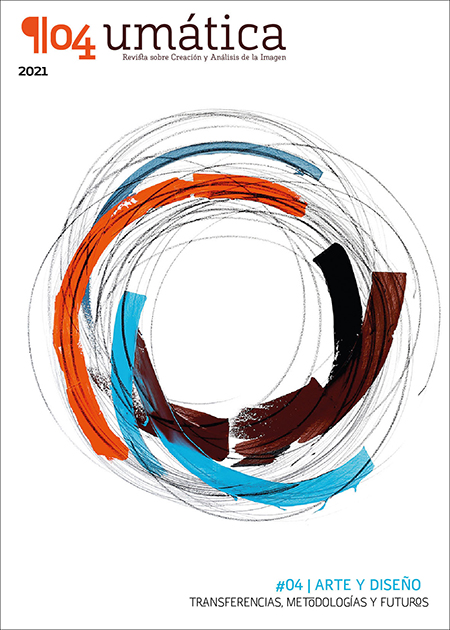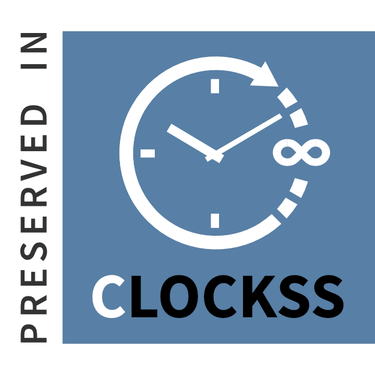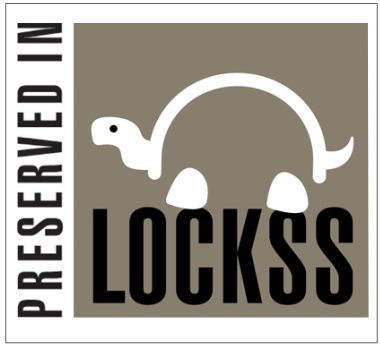Investigación en Diseño, Arte y tecnología como base de resiliencia e innovación
DOI:
https://doi.org/10.24310/Umatica.2021.v3i4.13134Palabras clave:
DISEÑO, TECNOLOGIA, ECONOMÍA CIRCULAR, ECONOMÍA CREATIVA, RESILIENCIA, IAResumen
El cambio de paradigma al que nos enfrentamos después de la crisis de la pandemia ha traído consigo una reflexión profunda acerca del modelo en que se desarrolla el progreso social y cómo es necesario marcar un tiempo nuevo en el que el diseño, la creatividad y la innovación transversal aplicada necesitarán ser trabajadas como disciplinas para su apropiación colectiva por la ciudadanía. 2021 se ha presentado como un año crucial en el que la economía creativa y los postulados de la nueva Bauhaus marcan claramente un discurso en el que las naciones toman conciencia de la importancia de las mismas como clave para la innovación, el desarrollo sostenible y, en fin, la recuperación económica. En este contexto, la investigación en arte y diseño aporta un nutriente de transferencia a la sociedad que se hace indispensable para el impulso de esa innovación transversal que ha de enfrentar un tiempo nuevo para la resiliencia y la sostenibilidad. Se presentan en este artículo las bases teóricas sobre las que se sustentan dos proyectos de investigación europeos en los que el diseño y el arte contemporáneo son puestos en relación directa a través de la inteligencia artificial, el machine learning y la economía circular con el fin de establecer conexiones entre artistas, artesanos, diseñadores, makers, productores y empresas de reciclaje a través de un modelo de gestión híbrido basado en las comunidades de conocimiento y el eco-diseño, integrando paradigmas de economía circular, economía creativa y economía colaborativa.
Dichos proyectos se abordan, además, desde el apoyo institucional que ha supuesto la creación de la primera cátedra universitaria de investigación de Innovación en Artesanía, Diseño y Arte contemporáneo que, desde la Universidad de Granada y junto al Centro Albayzín de Referencia Nacional de Artesanía aborda procesos de investigación, transferencia y formación en las tres áreas con el objetivo de abrir nuevas vías de desarrollo y emprendimiento para los jóvenes artistas, diseñadores y artesanos.
Descargas
Métricas
Publicación Facts
Perfil de revisores N/D
Información adicional autores
Indexado: {$indexList}
-
Indexado en
- Sociedad Académica/Grupo
- N/D
- Editora:
- Universidad de Málaga (España)
Citas
ASEE. (2016). “Envisioning the Future of the Maker Movement: Summit Report”. American Society for Engineering Education. Recuperado el 20/09/2021 de: https://www.asee.org/documents/papers-and-publications/papers/maker-summit-report.pdf
Braungart, M.; Mcdonough, W.; Bollinger, A. (2007). “Cradle-to-cradle design: creating healthy emission- a strategy for eco-effective product and system design” en Journal of Cleaner production, Elsevier.
Briceño Gutiérrez, A. (2017), Escenarios distribuidos, albores de un nuevo modelo, Fundación DID, Chile. Recuperado el 23/09/2021en http://www.fundaciondid.cl/wp-content/uploads/2018/05/escenarios_distribuidos_albores_AB.pdf
González Martín, C. (2020), “Prefico co-, innovación abierta desde la colaboración”, en GARCÍA LOPEZ, A. y Suárez Martínez, A. (Coord.), Repensar la artesanía. Estrategias para impulsar la artesanía contemporánea. Comares, Granada.
García López, A. (2020), “La investigación como estrategia para impulsar la artesanía” en GARCÍA LOPEZ, A. y Suárez Martínez, A. (Coord.), Repensar la artesanía. Estrategias para impulsar la artesanía contemporánea. Comares, Granada.
Suárez Martínez, A, (2021), “Nuevos paradigmas para la artesanía contemporánea en el contexto de la investigación en economía circular” en MESEGUER SÁNCHEZ, et. Alt. (Ed.), Economía circular: fundamentos y aplicaciones, Thomson Reuters Aranzadi, Pamplona.
Hatch, M. (2014). The Maker Movement Manifesto. DOI: 10.1162/INOV_a_00135
Hermida Balboa, C.; Dominguez Somonte, M. (2014). Economía circular como marco para el ecodiseño: el modelo ECO-3. Recuperado el 10/09/2021 de: https://www2.uned.es/egi/publicaciones/articulos/Economia_circular_como_marco_para_el_ecodiseno_el_modelo_ECO-3.pdf
Malakuczi, V. (2019), Computational by design, Common Ground Research Networs, University of Illinois Research Park, Campaign, IL. ISBN 9781863351218
Martín, J. (2017). La era del prosumidor. Recuperado el 02/08/2021 de Cerem: https://www.cerem.es/blog/la-era-del-prosumidor
Ritzer, G., Jurgenson, N. (2010). “Production, Consumption, Prosumption. The nature of capitalism in the age of the digital ‘prosumer’”. Journal of Consumer Culture, 10(1), 13-36. DOI: 10.1177/1469540509354673
VVAA_ Guía de recomendaciones y buenas prácticas. Producción y consumo de productos artesanos sostenibles, publicado por el Instituto para el fomento del desarrollo y la formación. Recuperado el 24/09/2021 de: https://drive.google.com/file/d/1OqfLwBEYnmM4ArQU0egnMMWgAXOOvdwD/view
VVAA_ Report on the situation of craftsmanship in Europe. CR@FTSMAN PROJECT ES/09/LLP-LdV/TOI/149072. Recuperado el 24/09/2020 de: http://projects.ifes.es/pdfs/craft/craft1.pdf
VVAA_ II Plan integral para el fomento de la artesanía en Andalucía (2014-2017). Recuperado el 12/09/2021 de: http://www.juntadeandalucia.es/turismoycomercio/publicaciones/143474860.pdf
Publicado
Cómo citar
Número
Sección
Licencia
Todos los contenidos publicados en Umática.Revista sobre Creación y Anáisis de la Imágen están sujetos a la licencia Creative Commons Reconocimento-NoComercia-Compartirigual 4.0 cuyo texto completo puede consultar en <http://creativecommons.org/licenses/by-nc-sa/4.0>
Se pueden copiar, usar, difundir, transmitir y exponer públicamente, siempre que:
- Se cite la autoría y la fuente original de su publicación (revista, editorial y URL de la obra).
- No se usen para fines comerciales.
- Se mencione la existencia y especificaciones de esta licencia de uso.
Los derechos de autor son de dos clases: morales y patrimoniales. Los derechos morales son prerrogativas perpetuas, irrenunciables, intransferibles, inalienables, inembargables e imprescriptibles. De acuerdo con la legislación de derechos de autor,Umática.Revista sobre Creación y Anáisis de la Imágen reconoce y respeta el derecho moral de los autores/as, así como la titularidad del derecho patrimonial, el cual será cedido a la Universidad de Málaga para su difusión en acceso abierto. Los derechos patrimoniales, se refieren a los beneficios que se obtienen por el uso o divulgación de las obras. Umática.Revista sobre Creación y Anáisis de la Imágen se publica en open access y queda autorizada en exclusiva para realizar u autorizar por cualquier medio el uso, distribución, divulgación, reproducción, adaptación, traducción o transformación de la obra.
Es responsabilidad de los autores/as obtener los permisos necesarios de las imágenes que están sujetas a derechos de autor.
Nota de copyright: Aquellos autores/as que tengan publicaciones con esta revista, aceptan y certifican los términos siguientes:
• Que ha contribuido directamente al contenido intelectual del trabajo, del cual se hace responsable a todos los efectos.
• Que aprueba los contenidos del manuscrito que se somete al proceso editorial de la revista UMÁTICA, REVISTA SOBRE CREACIÓN Y ANÁLISIS DE LA IMAGEN, y por tanto está de acuerdo en que su nombre figure como autor.
• Que el contenido del artículo no ha sido publicado y que tampoco figura en otro trabajo que esté a punto de publicarse.
• Que se compromete a no someterlo a consideración de otra publicación mientras esté en proceso de dictamen en la revista UMÁTICA, REVISTA SOBRE CREACIÓN Y ANÁLISIS DE LA IMAGEN, ni posteriormente en caso de ser aceptado para su publicación.
• Que no ha tenido ni tiene, relaciones personales o financieras que puedan introducir prejuicios y sesgos en el desarrollo o los resultados del presente trabajo.
• Que han sido mencionadas en el epígrafe de agradecimientos todas aquellas personas que, habiendo otorgado su permiso para tal mención, han contribuido de manera sustancial al desarrollo del trabajo.
• Que se compromete a facilitar, cuando así lo requiera la revista, el acceso a todos los datos y fuentes en los que se funda el trabajo presentado.
• Que participará activamente en la realización de todas aquellas modificaciones de estilo u orto-tipográficas que sean necesarias para la publicación del trabajo cuando así se lo notifique el equipo editorial de la revista.
• Que no ha violado, ni violará, las leyes y derechos humanos o animales durante el proceso de investigación y publicación de este trabajo.
• Que ninguna de las instituciones en las que desarrolla su labor científica e investigadora ha presentado objeciones con respecto a la publicación del manuscrito que se somete a evaluación.
• Que todos los datos y las referencias a materiales ya publicados están debidamente identificados con su respectivo crédito e incluidos en las notas bibliográficas y en las citas que se destacan como tal y, en los casos que así lo requieran, cuenta con las debidas autorizaciones de quienes poseen los derechos patrimoniales.
• Que los materiales están libres de derecho de autor y se hace responsable de cualquier litigio o reclamación relacionada con derechos de propiedad intelectual, exonerando de responsabilidad a la revista UMÁTICA, REVISTA SOBRE CREACIÓN Y ANÁLISIS DE LA IMAGEN
• Que en caso de que el trabajo sea aprobado para su publicación, autoriza de manera ilimitada en el tiempo a la entidad editora para que incluya dicho texto en la revista UMÁTICA, REVISTA SOBRE CREACIÓN Y ANÁLISIS DE LA IMAGEN y pueda reproducirlo, editarlo, distribuirlo, exhibirlo y comunicarlo en el país y en el extranjero por medios impresos, electrónicos, CD, Internet o cualquier otro medio conocido o por conocer.








23.png)








